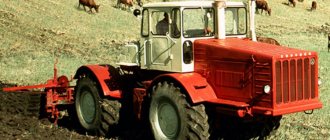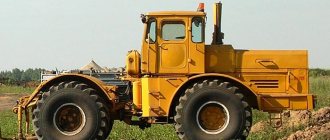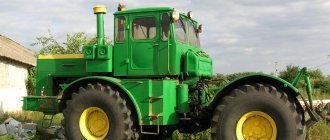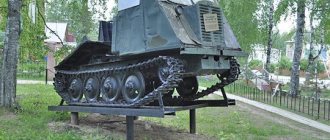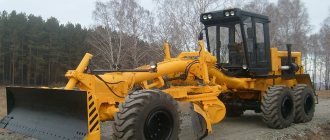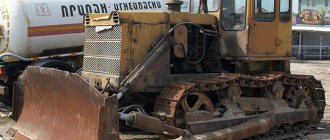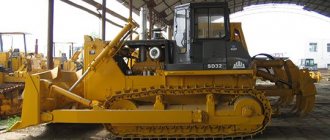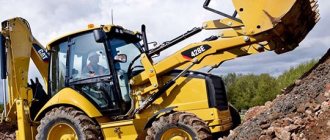Motor grader d 143 is a specialized machine designed to perform leveling operations during the construction of roads and technological sites. The production of equipment is carried out by the oldest road vehicle plant in Russia, Bryansk Arsenal. The experience accumulated by the enterprise has a huge impact on the final result - high-quality machines with high-tech and reliable equipment come off the assembly line. At the same time, the cost of equipment for the domestic market is quite attractive, which explains the great demand for the DZ model range. Despite the fact that foreign-made units can increasingly be seen in Russia, special vehicles from the Bryansk plant do not lose their relevance and are still used at many construction sites in the country.
Purpose
The motor grader "DZ 143" is designed to perform the following types of work:
- construction of embankments and shafts from soil;
- roadbed layout;
- slope profiling;
- roadside leveling;
- formation of a cross section of cuvettes;
- cleaning drainage ditches;
- picking old coatings;
- distribution of bulk material during the construction of road facilities;
- loosening of solid building materials;
- mixing different types of soil;
- opening of worn coatings;
- removal of construction waste;
- clearing areas of snow.
Content
p.
INTRODUCTION………………………………………………………………………………2
1 DESIGN FEATURES AND OPERATION OF MOTOR GRADER DZ-143……………………………………………………………. 3
1.1 Purpose of motor grader DZ-143…………………………………. 3
1.2 Composition of motor grader DZ-143………………………………………………………. 4
1.3 Installation of power motor grader DZ-143…………………………. 8
1.4 Kinematic diagram of the motor grader DZ-143……………………… 11
1.5 Operating cycle of motor grader DZ-143………………………………. 12
2 TECHNICAL AND OPERATIONAL INDICATORS OF MOTOR GRADER DZ-143…………………………………………………….. 13
2.1 Traction calculation……………………………………………………. 14
2.2 Calculation of motor grader performance………………………. 18
3 SAFETY INSTRUCTIONS WHEN OPERATING THE AUTO GRADER DZ-143…………………………………………………….. 21
CONCLUSION……………………………………………………… 22
LIST OF REFERENCES USED……………………… 23
INTRODUCTION
Currently, no construction can be completed without excavation work and machines performing this work (brush cutters, bulldozers, rippers, excavators, scrapers, etc.). The growth in the pace and volume of construction, and the increasing complexity of the design of structures being erected, has only increased the interest and need for machines for excavation work.
Today, many world-famous companies are engaged in their production. Some of them use their own original designs and create the design features of these machines, but in general the principles of their design and scope of application are the same.
Since the fleet of machines for excavation work is very large and diverse, both in terms of functions and the design of the machines, in this course project we will consider one of the machines of this class, namely the DZ-143 brand motor grader. Since motor graders are equipped with various replaceable additional equipment (up to 20 types), their scope of application is very wide. The motor grader is one of the most common and popular machines, which proves the relevance of this course project.
1 Design features and operation of the motor grader DZ-143
1.1 Purpose of motor grader DZ-143 [3]
The main purpose of the DZ-143 motor grader is profiling of the roadbed, construction of dirt roads at zero levels or on embankments erected from the soil of ditches, and leveling of soil surfaces. The motor grader can be used for picking (Fig. 1.1 a) soil and worn-out road surfaces, as well as for mixing soils with additives and binding materials on the road surface. All working operations of motor graders are carried out during longitudinal passages of machines using the main working equipment - a blade with various accessories (extender, extension, slope, ditch cleaner) and attachments (dozer blade, ripper (Fig. 1.1 b), snow blower, mixer, etc. .)
a) b)
Figure 1.1 - motor grader attachments
a) ripper; b) picker
studfiles.net
Specifications
Motor grader DZ 143 and its technical characteristics have the following meanings:
- the weight of the machine is 12.5 tons;
- maximum transport speed - 43 km/h;
- the minimum travel speed reaches 4 km/h;
- turning radius of the machine - 12.5 m;
- dimensions of the grader body: length - 3.74 m, height - 0.62 m;
- side extension - 0.8 m;
- the depth of the dump is 0.25 m;
- dimensions of the bulldozer blade: length - 1.3 m, height - 0.84 m;
- operating temperature range is from -40 to +40 C0;
- The machine is equipped with tires ranging in size from 14 to 20 inches.
The machine has the following dimensions:
- length - 8.95 m;
- width - 2.50 m;
- height - 3.51 m.
Be sure to read: Motor grader DZ 122
Engine characteristics
The power plant of the motor grader uses heavy diesel fuel in its operation. Depending on the configuration, the DZ 143 can be equipped with four-stroke engines of the following modifications: A-01 MS, D-108 and A-01ME. Their consumption is shown in the table:
| Model | Consumption, l/h |
| A-01 MS | 12,2 |
| D-108 | 10,0 |
| A-01ME | 12,2 |
Engine power is 130 horsepower. The number of cylinders is 6, their working volume reaches 11.15 liters. Crankshaft rotation speed - 1700 rpm.
Cabin
Even today, the motor grader cabin is considered quite comfortable for the driver. There is enough usable space for an operator of any height and build. Maximum visibility is achieved by glazing most of the cabin. All devices that monitor the state of the machine’s systems are located in the direct line of sight of the driver, which is very convenient and does not distract him from the work process. The disadvantages of the cabin include the lack of a climate control system. During the hot season, the driver regularly has to open the cab door, and this leads to a large number of dust particles getting inside.
Cabin of motor grader DZ-143
Dimensions, working equipment
The grader blade had the following dimensions: length - 3,740 mm, height - 620 mm. Similar indicators for the bulldozer blade are 1,300 and 250 mm. For the ripper-pick - 1,300 and 250 mm, respectively. The number of ripper teeth is three. Here are a few more characteristics of the grader blade.
| Lateral offset relative to the traction frame | 800 mm |
| Lowering below the supporting surface | 250 mm |
Additional equipment included a snow plow, push plate, utility brush, etc. In addition, it was possible to install a blade extension.
Device
The base of the “DZ-143” is a wheeled chassis with a 1x2x3 formula, made on a box-section frame. Due to the fact that its design provides for a forward tilt, visibility in the cabin has been significantly improved. The frame hinge allows it to rotate 26 degrees in both directions. The front part of the machine is equipped with a grader blade, and the middle part with a leveling knife. The machine is equipped with a six-speed hydraulic transmission, providing 6 forward and 2 reverse modes. The grader uses a hydraulically driven shoe-type brake system, the effect of which extends to the rear axle.
Autograder in the USSR in the post-war years
Despite all the efforts of the industry, the road industry during this period experienced an acute shortage of motor graders. At that time, mainly ineffective trailed graders were produced. In the V Five-Year Plan (the first half of the 50s), the factories of the Ministry of Construction and Dormash produced 10,124 trailed graders and only 1,628 motor graders. According to the plan, 1,500 motor graders were to be produced already in 1956, that is, almost the same number as during the entire previous five years.
Unfortunately, motor graders, developed in the first post-war years, did not fully meet the requirements existing at that time. In order to somehow bring the nascent production of new types of machines to a unified system, VNII-Stroydormash developed a type according to which three types of motor graders with engines of 50, 100 and 150 hp were to be produced in the USSR. The prepared projects provided that motor graders would have up to 10 types of replaceable equipment. An important feature was that they were united by a broad unification of the transmission, drive and control mechanisms.
DZ-6 belongs to the middle class of trailed graders; DT-54 and DT-75 tractors were used as tractors. All drives of the working mechanisms on the grader are mechanical, no hydraulics. Two large “wheels” at the rear served to raise and lower the knife; the knife was rotated using another wheel, similar to a steering wheel and standing on top of the frame; it is missing on the monument grader, only the bracket remains. The operator's seat is also missing, but the mechanism for changing the angle of the rear wheels, located above the rear axle, has been preserved.
The DZ-6 could be supplied by the factory with metal wheels, as on this example, and with pneumatic ones (on special order). A grader shod with rubber, of course, walked softer, but there was a risk of damage to the tires, especially if the work was done on rocky soils. The old DZ-6, distinguished by its simplicity and reliability of design, can still be found in operation in rural areas.
Motor grader V-1 (1949)
In 1949, serial production of light motor graders B-1 began at the Central Repair Workshop of Ushosdor, Estonian SSR (Paida). In the design of the motor grader, the engine, gearbox and axles were used from the GAZ-MM car. The control mechanism for raising and lowering the knife was carried out hydraulically, rotation of the knife in the horizontal plane, changing the cutting angle, steering and moving the knife to the side were done manually. Knife length 3050 mm, height 380 mm, lateral shift of the knife 320 mm, machine weight 3170 kg.
Motor grader D-144 (1949)
In 1949, the Chelyabinsk Road Machinery Plant named after. D.V. Kolyushchenko manufactured the first motor graders D-144, which were equipped with a blade with a blade 3660 mm long and a pick with 11 teeth. The blade could be rotated in a horizontal plane by 360°, in a vertical plane by 72°, the lateral offset of the knife was 380... 760 mm. The motor grader was equipped with a KDM-46 engine with a power of 93 hp. s., a clutch from the S-80 tractor and an 8-speed manual gearbox with a range, from which torque was transmitted to the main gear, balancers and drive wheels of the rear axles. All control mechanisms for the working equipment, except for the mechanism for changing the cutting angle, were driven mechanically from the engine through an independent power take-off, a special bevel gearbox and a control box located on the driver’s platform. Since 1955, the production of D-144 motor graders began at the newly built Oryol Road Machinery Plant.
Motor grader D-196 (1950)
In 1950, the Bryansk Road Machinery Plant mastered the production of light motor graders D-196. This motor grader has a KD-35 engine with a power of 37 hp. With. and the power transmission were located perpendicular to the direction of movement of the machine. A 6-speed manual transmission provided operating speeds of 3...5 km/h and transport speeds of up to 28 km/h. The driving wheels were the rear ones. The motor grader was equipped with a blade 3 m long. The angle of rotation of the blade in the horizontal plane was 360°, in the vertical plane - up to 70°. The lateral shift of the knife in the guides reached up to 700 mm. The motor grader was equipped with a 9-tooth pickaxe.
Motor grader D-265 (1952)
In 1952, the Bryansk plant began production of 3-axle light motor graders D-265 with mechanical control of the working bodies. The motor grader was equipped with a D-54 engine with a power of 54 hp. With. and a 6-speed manual transmission. The knife, 3040 mm long, was rotated in plan by 28...90° and in the vertical plane for cutting slopes - up to 80°. The lateral shift in both directions was 400 mm. The motor grader was equipped with a 7-tooth pick, bulldozer and snow plow. In 1958, in the production program of the Bryansk plant, it was replaced by a similar motor grader D-465, equipped with a simplified 6-speed gearbox in which the power take-off gears were also reverse gears and high ground clearance due to balancers of a different shape. The D-465 motor grader had a blade that rotated 360° in plan, but no longer had a side extension. The cabin was equipped with a dependent liquid heater.
Motor grader V-10 (1955)
In 1955, the plant in Paide (Estonia) began producing lightweight V-10 motor graders whose transmission units were borrowed from the DT-54 tractor and the ZIS-150 car. Torque from the D-54 engine was transmitted to the rear wheels through the clutch, driveshaft, DT-54 gearbox, multiplier, driveshaft, ZIS-150 rear axle and final drives. The control of the working bodies and the tilt of the wheels was hydraulic and carried out from the driver’s cabin. The steering is mechanical, using the steering mechanism of a ZIS-150 car. In 1962, the Paide Road Machinery Plant switched to producing D-512 motor graders, which differed from the B-10 in the length and height of the blade, as well as the ability to rotate the blade in plan by 360°. The motor grader was equipped with an SMD-14 engine with a power of 75 hp. With. and a 6-speed reverse gearbox.
Motor grader D-426 (1957)
The middle-class motor grader D-426, produced since 1957 by the Oryol Road Machinery Plant, was distinguished by the presence of two drive axles with all steered and driven wheels and hydraulic control of the working bodies. The YaMZ-204A engine with a clutch and 5-speed gearbox was installed behind the cab. Torque from the gearbox was transmitted by cardan shafts to a single-stage transfer case and then to the drive axles. The axle axles of the bridges were of the unloaded type, the wheel axles rotated in both directions at an angle of 30°, and there was no mechanism for tilting the wheels. The presence of steerable rear wheels made it possible to move the front axle away from the axis of the car, thereby achieving lateral stability. Flat profile knives were installed on the motor grader, and the blade, turntable and traction frames were unified with the D-144 motor grader. The control of all working and auxiliary operations, as well as the steering, was hydraulic. Raising and lowering the left and right sides of the blade independently was carried out by two hydraulic cylinders installed on each side of the main frame. The double cabin was heated by exhaust gases.
As can be seen from the Type, there was a gap in domestic production for 150-horsepower motor graders. In 1955, design began, and from 1959, serial production of the new machine began. To speed up the development of the project and bring it closer to production, in August 1956 the design was concentrated at the Chelyabinsk plant. Designers from VNIIStroydormash, its Leningrad branch, Bryansk and Oryol road machine plants arrived in Chelyabinsk. About 100 people took part in the work; on December 26, 1957, the first heavy-type motor grader D-395 went to the world exhibition in Brussels. The evaluation of the new car exceeded all expectations - a big gold medal! The appearance of a Soviet motor grader at such an authoritative exhibition was a complete surprise for leading foreign companies, which suddenly discovered a serious competitor.
In 1957, the Plant named after. D.V. Kolyushchenko began producing heavy D-395 motor graders with all drive wheels, designed for road construction in difficult conditions. In 1957, at the World Exhibition in Brussels, this motor grader was awarded
Large gold medal and diploma. The vehicle was equipped with 16.00-24 tires with adjustable pressure, providing the vehicle with good grip on the soil and high maneuverability on waterlogged soils. The side members and the transverse pipe of the rear part of the frame simultaneously served as receivers for the pneumatic system. The vehicle was equipped with a U2D6 engine with a power of 150 hp. p., clutch, mechanical 4-speed gearbox, 2-speed speed reducer, transfer case, from which drive shafts transmitted torque to three drive axles with a bevel final drive and spur final drives with internal gears. The steering was equipped with a pneumatic servo booster. The working bodies were controlled mechanically, by means of a control box, the cam clutches of which were activated using pneumatic cylinders. Replaceable equipment included a pickaxe, a bulldozer or a snow plow.
Motor grader D-395 (1957)
In the mid-1950s. The Korosten road machinery plant "Oktyabrskaya Kuznitsa" mastered the production of trailed graders D-20B and D-241, previously produced by the Bryansk plant, in the mid-60s it switched to the production of graders D-20BM and D-241A, and since 1976 - graders DZ -58 (D-700) with hydraulic control of working bodies, which were designed to work in conjunction with hydraulic tractors T-100MGP and K-700A. The DZ-58 grader was equipped with a knife 3616 mm long and 500 mm high. The design of the grader was unified with mechanical models.
Trailed grader DZ-58 (D-700)
In 1958, the Bryansk plant mastered the production of D-446 motor graders with hydraulic control of the working bodies. The motor grader was equipped with an SMD-7 engine with a power of 65 hp. p., 3-speed gearbox with 2-speed speed reducer. The blade was rotated by a hydraulic motor through a worm gearbox. The hydraulic steering was of the servo type. The motor grader was equipped with an extension and a blade widener, a slope, a pickaxe, a bulldozer and a snow-clearing blade. In 1964, the plant switched to the production of motor graders with hydraulic control D-598A, equipped with a 60-horsepower diesel engine D-60K-S1, and later D-598B with an SMD-14 engine with a power of 75 hp. With. In 1967, the plant mastered the production of D-710 motor graders with an AM-41 diesel engine with a power of 90 hp. s., and in 1972 - DZ-99 motor graders with an A-41 engine of the same power. Later, the Bryansk Road Machinery Plant switched to producing middle-class motor graders equipped with an A-01 engine with a power of 130 hp. pp.: since 1984 DZ-143, and since 1991 DZ-180.
Motor grader D-710 (1967)
In 1966, the Oryol Road Machinery Plant mastered the production of motor graders D-557 (DZ-31) with hydraulic control of the working bodies. They were equipped with an AM-01 engine with a power of 110 hp. p., a clutch with a mechanical release drive and a dual-range 6-speed manual transmission connected to the engine by a cardan transmission. The driving wheels were rear. The torque on them was transmitted by a driveshaft through the main gear and balancers. The length of the knife was 3700 mm, height 565 mm, offset to the side - 800 mm, cutting angle of slopes
.90°. Modifications were produced: DZ-31 S in the northern version and DZ-31-2 with a hydromechanical transmission. In 1980, the Oryol plant mastered the production of the DZ-122 motor grader.
Motor grader D-557 (DZ-31), 1966
In 1971, the Chelyabinsk plant named after. D.V. Kolyushchenko begins production of motor graders DZ-98 (D-395V), which, unlike the D-395, were equipped with a U1D6-250TK engine with a power of 250 hp. s., hydraulic control system for working bodies, cardan transmission to the front axle with a maximum shaft misalignment angle of 7°, water heating system for the cabin with blown windshields. The motor grader received a new engine hood with shutters for the fan and wheel brakes with sintered metal discs.
The design of the motor grader has been modernized several times, and the motor grader is still produced under the designation DZ-98V.
Motor grader DZ-98V
Currently, motor graders in the Russian Federation are produced by Bryansk Arsenal OJSC, Chelyabinsk Road Construction Machines CJSC, and Dormash CJSC (Orel). The production of lightweight two-axle motor graders designed to perform small volumes of work is carried out by Bryansk Arsenal OJSC and the holding company (SMM-Holding, Bryansk).
Advantages and disadvantages
The motor grader was developed in Soviet times, so the machine absorbed many of the positive qualities of that time. These include:
- reliability of the unit;
- simplicity of design;
- high power;
- multifunctionality;
- ease of machine control;
- long service life;
- reasonable cost.
Be sure to read: Technical characteristics of the Amkodor harvester
The car was not spared from its shortcomings . The motor grader does not have air conditioning equipment, which negatively affects the driver’s condition when working in hot weather.
Model of motor grader DZ-143
Catalog of auto grader DZ-143 produced by Bryansk Arsenal
Grader DZ-143, produced by Bryansk Arsenal. The motor grader represents the middle class of dz. Spare parts for the DZ 143 auto grader, as well as the technical characteristics of the DZ-143, can be found in the presented catalog. The catalog of the road construction machine DZ-143 presents each unit separately, the catalog number of the item is indicated in the table of the unit, spare parts. Place an order using the catalog. You can call us or send a request on-line, katalogdz143. You will be pleasantly surprised by the price and timing of spare parts for DZ-143. Catalog, buy spare parts for the motor grader DZ-143, main frame assembly DZ-143 with catalog number 225.81.01.01.001-01, front axle assembly DZ-143, working equipment assembly DZ 143, blade rotation gearbox DZ 143, rear trolley or rear axle assembly DZ-143, rear axle gearbox DZ-143, oval balancer DZ-143, wheel brake DZ 143, hydraulic distributor DZ-143, hydraulic blade lift cylinder DZ-143, hydraulic blade offset cylinder DZ 143, hydraulic wheel steering cylinder DZ-143.
Main frame DZ-143 Solid frame 225.81.00.00.000-01
Bulldozer DZ-143 (front shovel)225.21.00.00.000
Ripper-picker DZ-143225.39.00.00.000
Cabin, lining DZ-143225.34.00.00.000
Front axle DZ-143225.56.00.00.000
Working equipment of grader DZ-143 225.07.00.00.000
Rear trolley DZ-143 Tikhvin gearbox 240.03.00.00.000
Cardan drive / ICE / Radiator installation
Brake system DZ-143
Hydraulic system DZ-143
Brake system DZ-143
Electrical equipment DZ-143
Gearboxes: Manual transmission
www.speczapchast.ru
Reviews
You can form an evaluative opinion about the DZ 143 based on the reviews left by the grader drivers. Here are some of them:
- The machine has a large margin of safety; even after scheduled repairs, it can work for more than one year without any breakdowns.
- There are no problems with purchasing original spare parts, since the plant produced a large volume of repair kits and materials, which are still sold by many commercial companies in the country to this day.
- A large amount of additional equipment can be installed on the unit and can be used not only in summer, but also in snowy winter. In cold weather, the cabin is comfortable and warm, and all thanks to the powerful stove.
What can be included with
Grader DZ 143 and its operating manual provide for the possibility of equipping the machine with additional working parts:
- A pickaxe with teeth. Thanks to this device, you can loosen hard soils and open worn-out surfaces during repairs: asphalt concrete and crushed stone.
- Sweeping brush. This equipment configuration is very effective in the summer. It allows you to effectively work on road maintenance: removing soil deposits from the edge of the pavement and removing debris from the roadway.
- Road plow. This device is used to organize passages in areas with deep snow. It is popular when carrying out work to remove large amounts of snow on roads and airfields.
- Side snow blower. This item is a traditional blade that is mounted to the right side of the grader and ensures that snow is thrown beyond the boundaries of the cleared area.
- Ice cutter. With the help of this body, ice and masses of compacted snow are removed from the roadway. It is worth noting that when carrying out work in winter, the machine is additionally equipped with snow chains, which are installed on the rear wheels of the machine
Be sure to read: Price for new and used grader
Cost of new and used
“DZ 143” has long been out of production, and the price of used copies ranges from 1.5 to 1.7 million rubles. This is the value of a car in good working condition. There are also cheaper varieties of this model on the market, but they will require significant financial expenditures to eliminate various types of malfunctions and restore the operating functions of the unit. A motor grader is a specific and rather expensive type of special equipment. Therefore, not every company can afford to purchase, effectively operate and maintain it in its fleet. There is only one way out in this situation - rent a car for a certain period. In this case, the financial losses will not be so great, since the cost of one machine shift will be 14 thousand rubles.
Analogs
Analogues of the “DZ 143” are represented by the following machines: XCMG GR180, ChSDM GS-14.02 and Caterpillar 120K. Their technical characteristics have the following meanings:
| Model | Operating weight, t | Engine power, kW | Travel speed, km/h | Turning radius, m | Blade depth, m |
| XCMG GR180 | 15,4 | 140 | 38,0 | 7,3 | 0,50 |
| ChSDM GS-14.02 | 12,8 | 110 | 32,0 | 7,8 | 0,38 |
| Caterpillar 120K | 13,8 | 93 | 47,5 | 7,3 | 0,77 |

